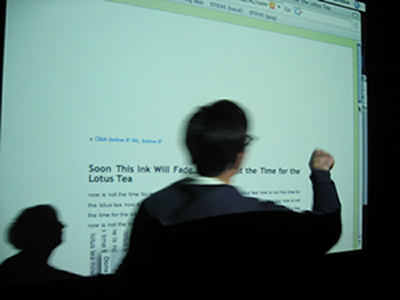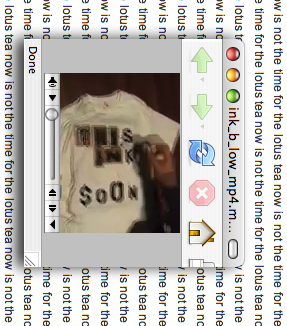Reflections on Warm Not Cold performance of April 11th.
Comments by members of the Death, Data, & Desire class, formulated by Trebor Scholz. Photos by Camille.pb and Tom Leonhardt.

The unreliable fleeting nature of the Internet conditions the art created for it. The fact that things did not work out made up the strength of the piece. Failure as window of possibility. The screen exerts its power. We are so used to screen-based worlds and it is a relieve to see this embodied focal point pulling participants away from the screen. The performance becomes a dialogue between the computational surface and the person.



Questions:
How would it change the performance if parts of the web interaction would be prerecorded as screen video? How can the drama of the Internet, with its possible, incalculable shutdowns be heightened? What did the social game focus on? Where did it lead people? The emotional, spontaneous interaction with the interface of the audiovisual blog is highlighted.
The performer, unlike the powerpoint lecturer, disrupts the peace of the pacified armchair passenger, one-to-one with the screen. Here, the performer is happening, intermingling screen realities with hot bodies. He creates an uncomfortable closeness in the black box space. He makes the participants aware how they interact with media.

Performance props: A small bag of things that you are choosing to take on a trip. The slow motion of the performer as opposed to the nervous, rapid flickering speeding mouse on screen. Should remote performers, distributed, controlling the performer from afar become part of the piece?


The performer loosens up the people in the room: “Cakes and jam!,” animations, sms from your cell phone to the screen. The tension between documentation of the performance and the performance itself blurs the borderline between the artwork on the screen and the embodied artist. The performer breaks open the audience grid to activate open social behavior. Blogs move “users” in very predesigned paths.
“One day I broke the CSS of the blog and all elements of the blog were mashed up. I thought- yeah, that’s it. I’d like to play with these formats.” Blogs merely allow us to inflict styles. It takes the technically informed user to randomize these preset patterns.
Class Suggestion:
Use of ultra small projectors. Projecting onto bodies. Cellphones project (http://wiredblogs.tripod.com/gadgets/index.blog?entry_id=1460989) a keyboard, letting you type. Project your cellphone.
Art and research. Understanding your process and outcomes through process documents. Reflect on your process. “Art practice qualifies as research when its purpose is to broaden our knowledge and understanding through an original investigation.” What does it mean to do research?
Theory and production/practice don’t marry like bread and jam. Their convergence is a process that needs to be learned. Once established the artist becomes a participant-observer. He reads and works. His production experience informs the way he grasps the texts. Snippets from essays may inform and inspire production. The act of making becomes the process of taking part in a conversation: discourse.















